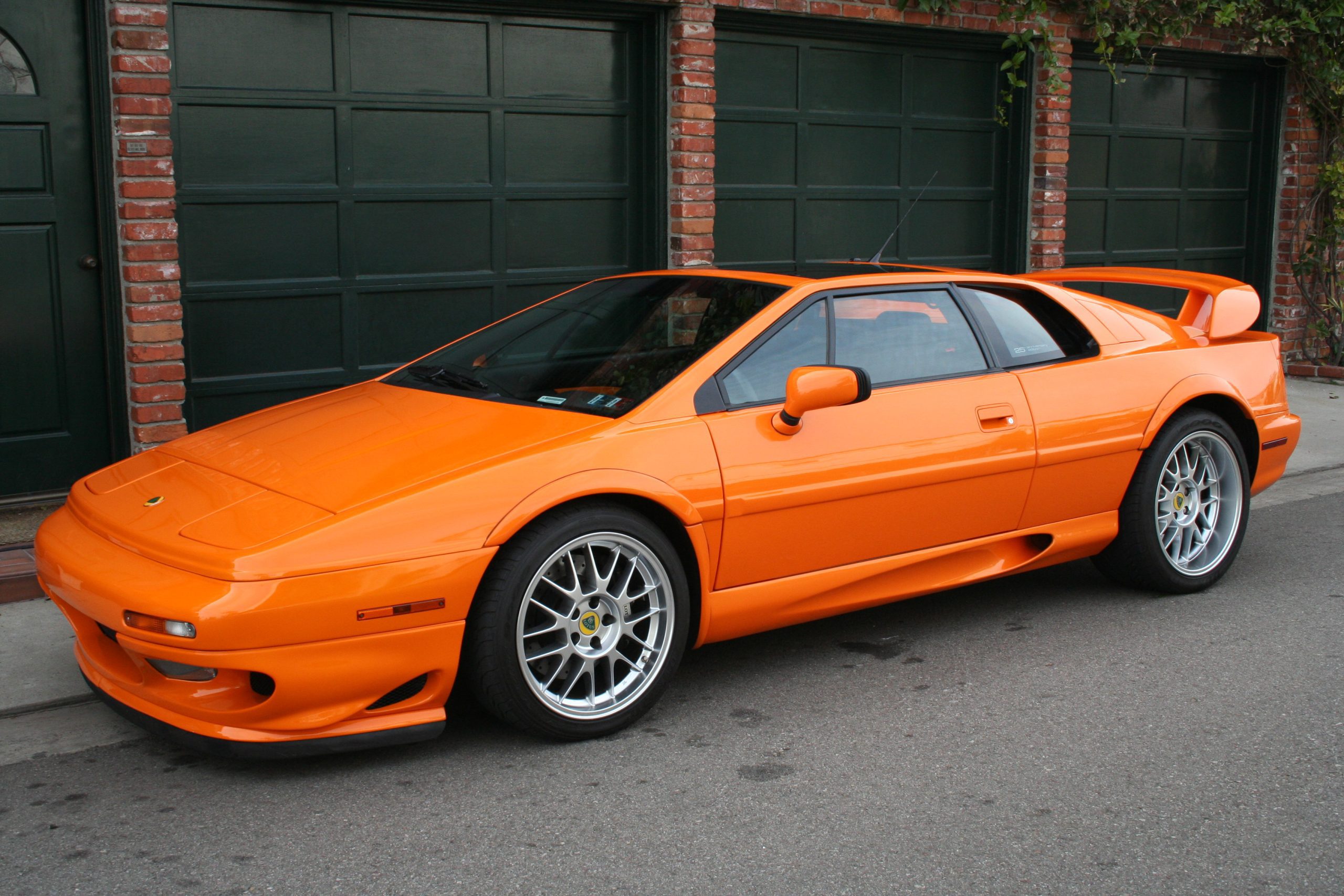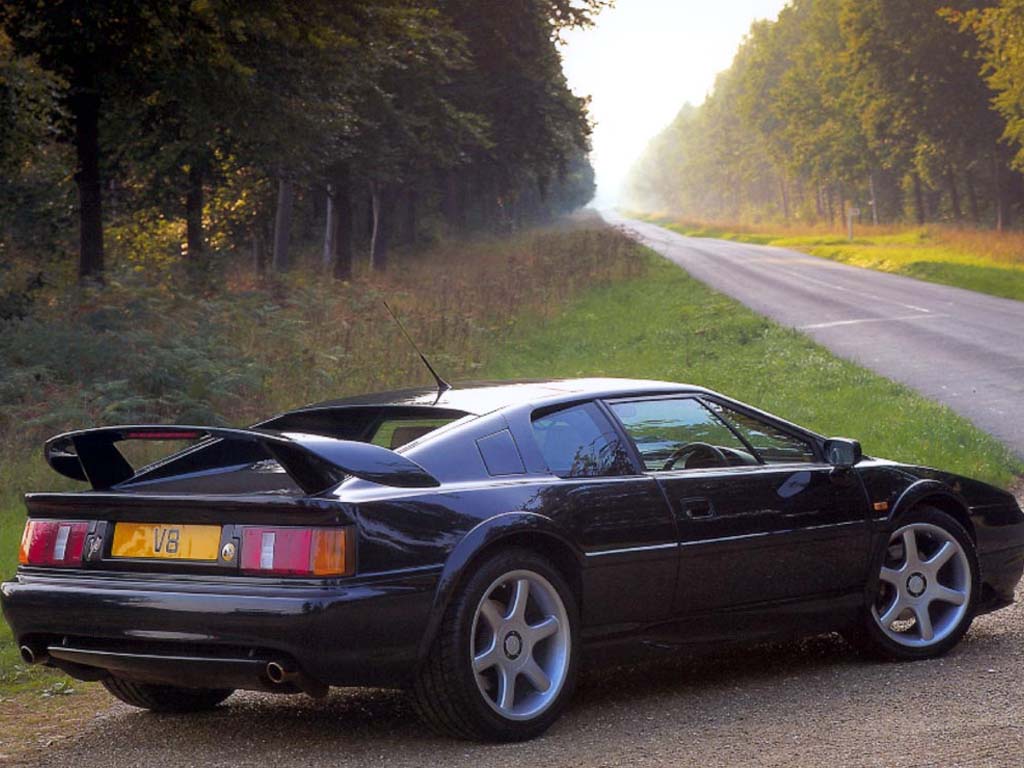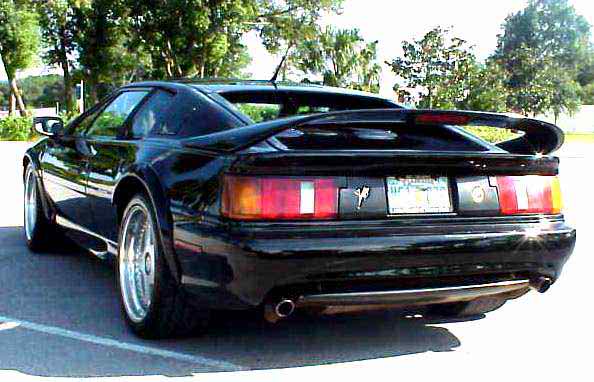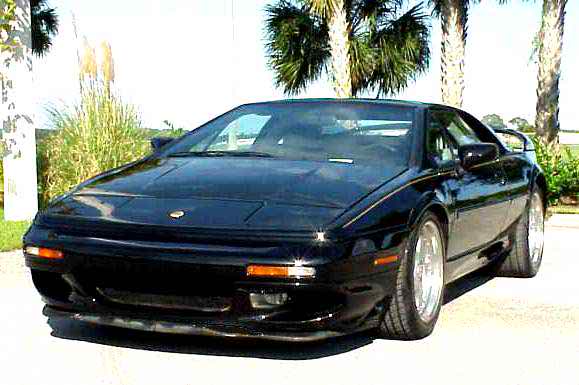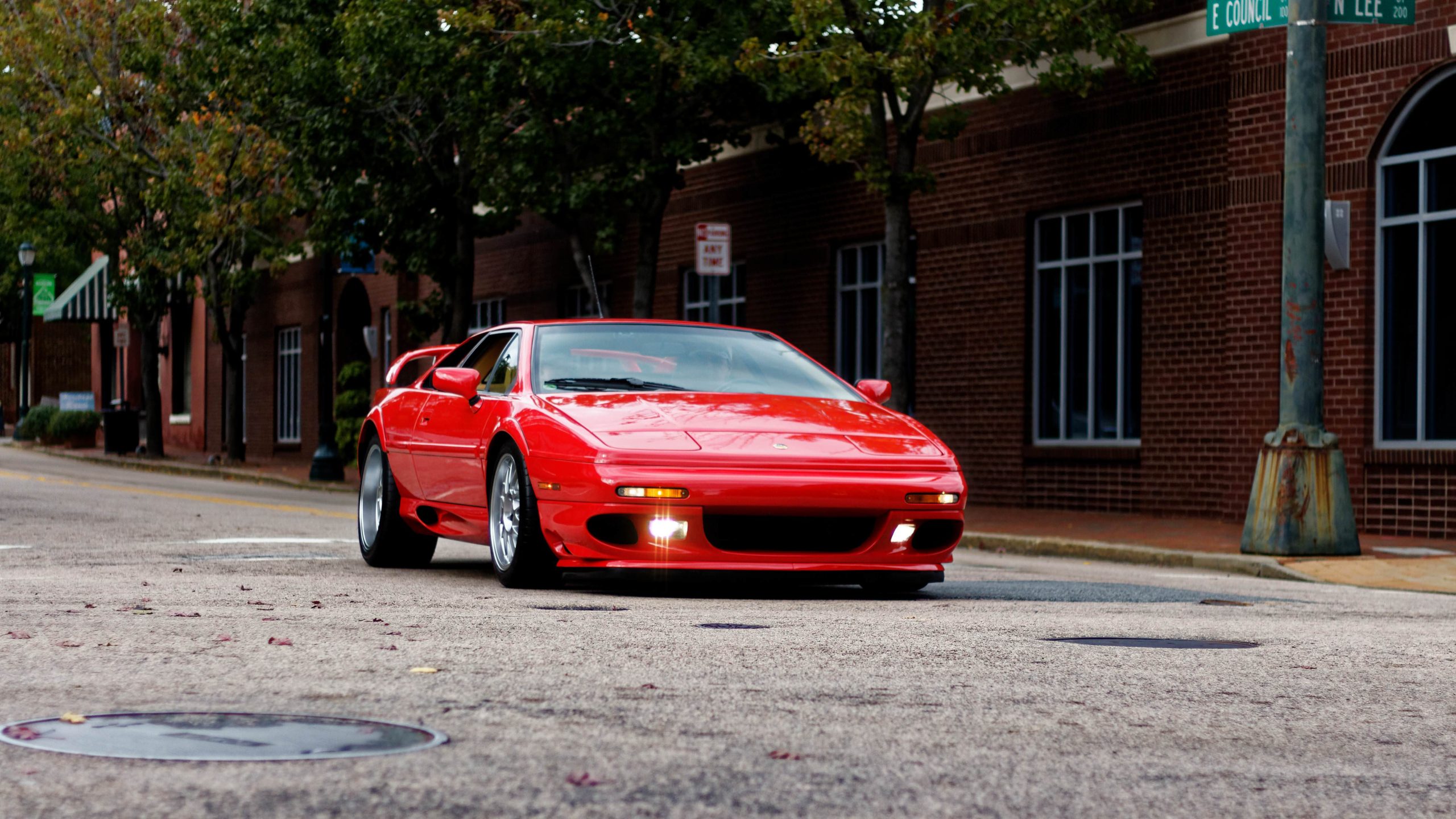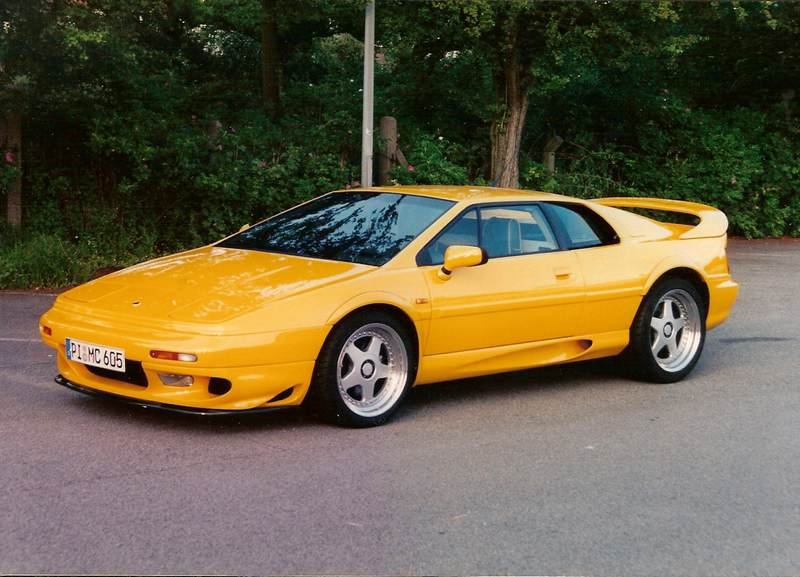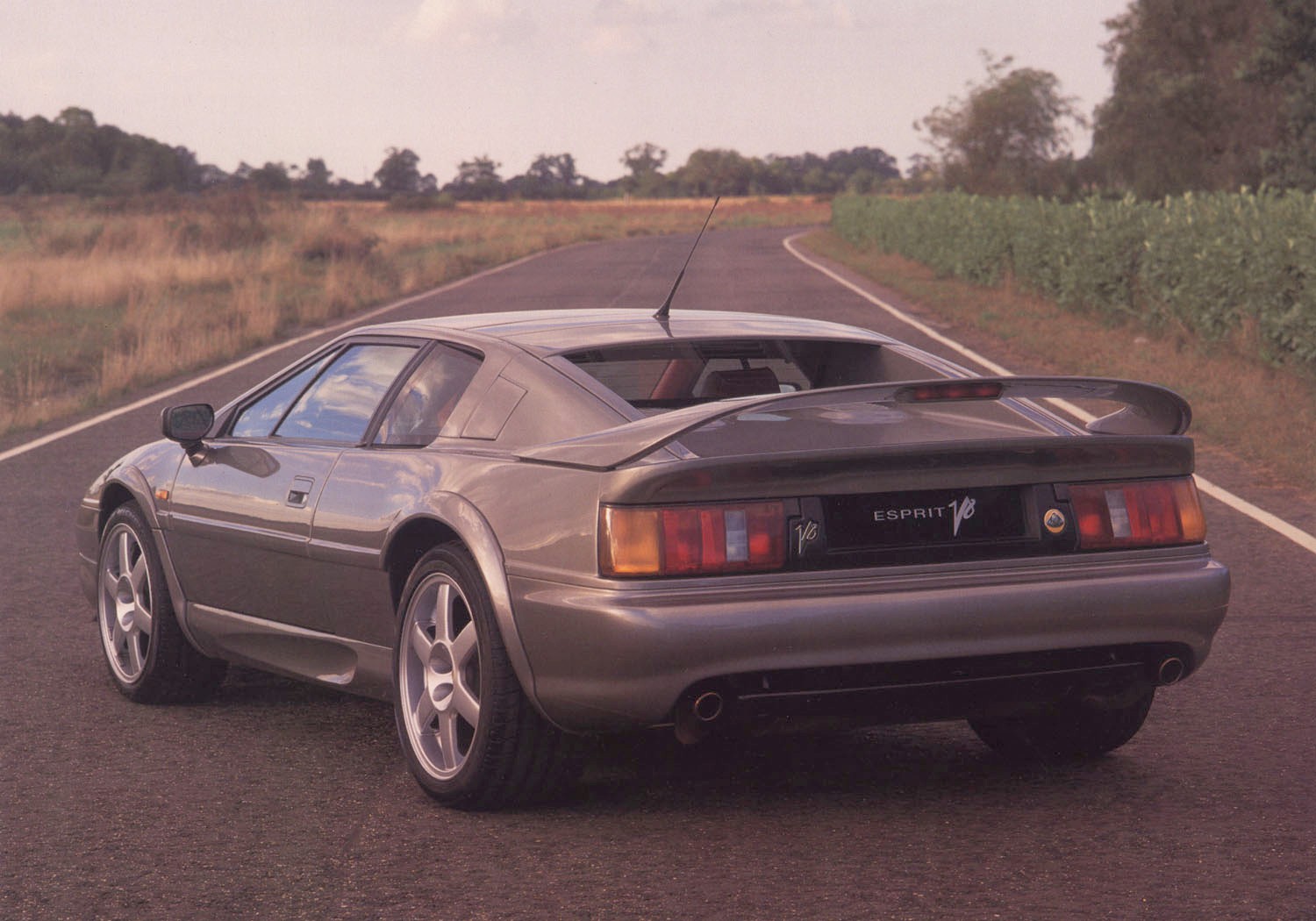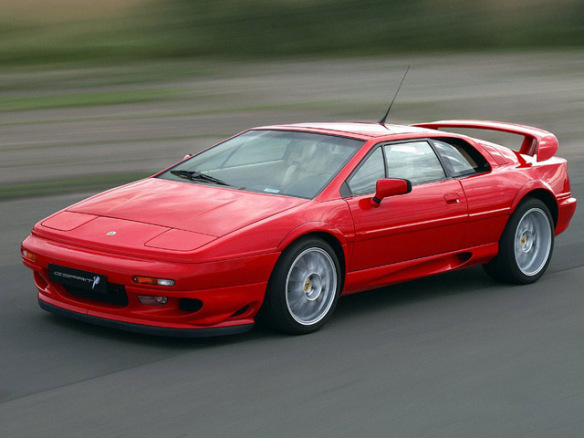1996 Lotus Esprit V8
Years: 1996-2004
Names: V8 / Type 85
Units: 1,237 (including GT & SE)
Engine: 3,506 cc twin-turbo V8
Power: 349.9 bhp @ 6,500 rpm
Torque: 295 ft lbs @ 4,250 rpm
0-60 mph: 4.4 seconds
1996 was the year that saw the Esprit finally gain the V8 it had deserved for so long. The exterior was left pretty much alone except for some bigger wheels. The addition the twin-turbo V8 saw a big increase in performance. In 1998 the V8 range was split into SE and GT models.
Twin turbochargers and a V8 engine, 355PS (260kW) and 175mph (274km/h) — the Esprit V8 has all the right supercar credentials and then some. Low, wide, and sleek, the Esprit is the absolute epitome of the mid-engined supercar. Other-worldly acceleration and crowd-pulling styling are only a part of the Esprit V8 and V8GT impressive repertoire of talents. Exhilarating handling and phenomenal levels of roadholding are also in the package, together with high levels of refinement and luxury appointments.
The Esprit V8 offers the complete supercar experience — exhilarating all-round performance blending seamlessly with comfort and luxury. There’s no more stylish way to enjoy the thrill of the open road.
There is simply no mistaking the stunning, sweeping lines of the Lotus Esprit. A true thoroughbred, its looks are unsurpassed, its pedigree unquestioned, its sheer beauty unequalled. The Esprit is much more than a mere car. It is the experience of perfect balance meeting exquisite design and engineering, it is phenomenal power, absolute control and devastating performance. The Esprit remains a truly exceptional road-going racecar.
At the heart of the Esprit beats one of the most advanced powerplants in production today. Innovative design has created an efficient, compact and lightweight engine that easily pumps out 100hp per litre in standard road form. Racing versions are currently producing over 550hp with very few changes from the standard road engine.
The Esprit V8 is an extremely refined and responsive supercar, designed to meet all our customers’ requirements, offering an exciting blend of power, chassis performance and pure driving satisfaction.
The Esprit V8 is powered by the Lotus designed 3.5 litre twin turbocharged V8 engine. The product of thoughtful design, the engine is efficient, compact and lightweight — weighing less than 220kg complete with all ancillaries. With up to 350 bhp (260 kW) at 6500 rpm available, the Esprit V8 accelerates from 0-100 km/h (0-62mph) in 4.9 seconds, 0-160km/h in 10.3 seconds (0-100mph in 10.54 seconds) before reaching a certified top speed of 280km/h (175 mph).
Pictures
Specs & Performance
| submitted by | Richard Owen |
| price $ | $79 325 USD |
| engine | Twin Turbo V8 |
| valvetrain | DOHC 4 Valves / Cyl |
| displacement | 3500 cc / 213.6 in³ |
| bore | 83.0 mm / 3.27 in |
| stroke | 81.0 mm / 3.19 in |
| compression | 8.0:1 |
| power | 260.9 kw / 349.9 bhp @ 6500 rpm |
| specific output | 99.97 bhp per litre |
| bhp/weight | 253.37 bhp per tonne |
| torque | 399.9 nm / 295.0 ft lbs @ 4250 rpm |
| redline | 7000 rpm |
| body / frame | Fibre Composite |
| driven wheels | Mid Engine / RWD |
| front tires | 235/40TR-17 |
| rear tires | 285/35ZR-18 |
| front brakes | Vented Discs w/Vacuum Assist & ABS |
| f brake size | x 295 mm / x 11.6 in |
| rear brakes | Vented Discs w/Vacuum Assist & ABS |
| r brake size | x 300 mm / x 11.8 in |
| front wheels | F 43.2 x 21.6 cm / 17.0 x 8.5 in |
| rear wheels | R 45.7 x 25.4 cm / 18.0 x 10.0 in |
| steering | Rack & Pinion w/Power Assist |
| curb weight | 1381 kg / 3045 lbs |
| wheelbase | 2438 mm / 96.0 in |
| front track | 1529 mm / 60.2 in |
| rear track | 1544 mm / 60.8 in |
| length | 4369 mm / 172.0 in |
| width | 1867 mm / 73.5 in |
| height | 1151 mm / 45.3 in |
| transmission | 5-Speed Manual |
| gear ratios | 3.36:1, 2.06:1, 1.38:1, 1.04:1, 0.82:1, :1 |
| final drive | 3.89:1 |
| top speed | ~286.5 kph / 178.0 mph |
| 0 – 60 mph | ~4.4 seconds |
| 0 – 100 mph | ~11.0 seconds |
| 0 – 1/4 mile | ~13.0 seconds |
Lotus Esprit V8 Reviews
BBC Top Gear Road Test 1998 – What They Said
Like tortoises, supercars live a long, long time. Also like tortoises, supercars move (out of showrooms, at least) very, very slowly. No one except Ferrari (the hare of the supercars game) can afford to replace cars that sell in tiny numbers very often. Instead they polish their shells and give them fresh lettuce to make them look smarter and go faster.
The Lotus Esprit is a case in point. It’s been around since our Zac was a schoolboy sneaking in to see Roger Moore drive one in The Spy Who Loved Me. And it’s been tarted up on an annual basis ever since. A couple of years back, the Esprit got a bigger makeover than most when Lotus (after years of thinking about it) finally put a V8 engine into its mid-engined chassis rather than just rely on the old two-litre turbo. Now it’s time for a few more tweaks so we see a new interior, improved clutch and gearchange and various other more minor updates. If you’re into Esprit-spotting you’ll also notice a different rear wing, mounted higher and on the rear hatch cover. Enough excuses, then, for another go in Britain’s only mid-engined supercar.
And go the Esprit V8 most certainly does. The twin-turbocharged 3.5-litre V8 that Lotus developed especially for this car might sound more like a witch’s cackle than an angelic choir but it can certainly deliver the performance goods. Understandably so; the Esprit packs a power-to-weight punch better than anything bar a Cerbera so it will top 170mph and hit 100 from a standstill in under 11 seconds.
You’d be hard pressed in routine driving to spot that the Lotus engine uses a turbocharger ” merely stunned by its shattering acceleration when you floor the throttle. It’s up through the rev range so quickly in the lower gears that you’re fumbling for the next gear while still coping with the blast through the last one.
Be a little more analytical about the engine, though, and you’ll discern a slight mildness low down that makes the surge of speed, when it comes, even more spectacular. There isn’t the same instant throttle response that comes in a non-turbo performance motor. That lack of instant throttle response and the stiff clutch do cause embarrassing stallings early in one’s time with the Esprit too. The clutch and gearshift have supposedly both been improved in this latest V8 but, to be honest, you could have fooled me. The clutch may be lighter but it’s still snappy and the shift is still slow and needs a very firm push or pull between gears, reverse being particularly awkward.
But you soon forget all this when you get the Esprit out on to some country roads. There is something special about a Lotus chassis ” the ability to put together a supple ride that just seems to get more comfortable the faster you go.
The brakes are awesome too, able to stand the car virtually on its nose without the ABS kicking in too soon, and the steering is as good as they come.
And so, finally, to the new interior ” the point, after all, of a day’s thrash in the Esprit. At last Lotus has shed the wood-and-leather look (much to the relief of a few cows, no doubt) which was as ’70s as a Roger Moore hairdo. Instead, it’s gone for the minimalist approach with a simple four-dial binnacle in front of the driver and neat push-buttons on a redesigned centre console. It’s simple, smart and vaguely reminiscent of the way Ferrari do things ” but horribly let down by a nasty flat panel across the front of the screen which carries big, ugly Pioneer speakers and looks like something a Max Power reader bodged in.
Like all such cars, the Esprit is a bit of an inelegant struggle to enter or leave ” this usually becoming a sort of semi-crawl onto the pavement. It’s more cramped inside than some. The driving position’s fine if you’re about five-nine but a squash if you’re taller and, as previously mentioned, the pedals are small, tight together and irritatingly offset. There’s also only a tiny map pocket at the back of the seats, so if two or you are in the car your coats and everything else has to go into the boot (which is, in estate agent speak, ‘deceptively spacious’).
You can live with all this but the terrible rear vision ” most of the slit-like rear window is filled by the spoiler ” and the way headlights reflect off the glass and the rear buttresses at night can make the Lotus a tiresome pain in the neck in traffic.
Still, for what is a 23-year-old, it does well. Plenty of newer rivals will envy its performance and chassis. There’s plenty of life left in this tortoise.
Autocar Test Lotus Esprit V8 1996 – What They Said
With all the hype surrounding the remarkable new Elise, it’s easy to forget Lotus’s other new car, the Esprit V8. It may not be quite as fresh to look at, the design has been around in one form or another for 21 years, but as far as the future of Lotus is concerned, its success is paramount. The engine alone is understood to have cost nearly £5.5 million in research and development fees, £1.5 more than the entire Elise budget. It’s one of the main reasons that Lotus’s finances are currently so shaky. If, however, it succeeds in rekindling the Esprit’s dwindling flame, it will have been worth it. With the performance, efficiency and development potential to power a whole new range of 21st century sports cars, it could yet prove to be Lotus’s lifeline to the future.
Performance & Brakes
For all the criticisms leveled at the Esprit, a shortage of performance has never been among them. The old turbocharged, intercooled 2.2-litre lump was pumping out 300bhp at the end of its life and rocketed an S4s from 0-60mph in 4.7sec and on to a top speed of 162mph.
All the more impressive that the new 3.5-litre V8 engine manages to make even these figures look faintly pedestrian. The 3.5-litre all-aluminium V8 uses two low-pressure turbochargers running at 0.5bar to serve up 349bhp at 6000rpm. Take into account the extra weight of the V8 engine (around 50kg, according to Lotus) and the Esprit V8 can count on a power-to-weight ratio of 260bhp per tonne, more than any other rival bar the monstrous TVR Cerbera.
It’s an advantage that the Lotus makes full use of, streaking to 60mph from rest in 4.2sec and on to 100mph 6.1sec later. On the way it collects the scalps of the Porsche Carrera 2, Chrysler Viper and Honda NSX, not to mention the vastly more expensive Ferrari F355. That’s an impressive tally by anybody’s reckoning, even if its 172mph top speed is slightly down on the last’s 173mph.
The key to this extraordinary performance is the colossal mid-range pull of the V8 engine. Maximum torque of 295lb ft comes into play at 4250rpm but, judging by the car’s gutsy fifth gear performance, most of that is available from 2500rpm onwards. Let the engine fall below this speed and it still feels a bit flat as the turbos start to gather speed. The absurd all-or-nothing kick of the highly strung four is long gone, but the V8 still lacks the instantaneous throttle response and ever-increasing thrust of the best naturally aspirated engines. Down-changing requires a deliberate prod of the throttle and a carefully timed gearchange rather than a quick blip followed by a flick of the lever.
The aral enticement is the engine’s only other disappointment. The flat-plane crankshaft design robs it of the usual V8 burble, while the turbochargers and stringent drive-by noise regulations prevent production Esprits from making up for the lack of quality with outright quantity. A better-sounding after-market sports exhaust is available from Lotus dealers for £393.
The Renault-sourced gearbox cannot be so easily remedied. A new twin-pate AP racing clutch, which reduces pedal effort, and softer springs in the gear selector will soon become standard on production Esprits, but our car came with an intermediate solution which still left a number of question marks hanging over the car’s driveability. The ventilated disc brakes, by contrast, are something of a revelation. The pedal travel may be a little too short for progressive low-speed braking, but the new Kelsey Hayes three-channel anti-lock controller is far superior to the old system, allowing maximum retardation before cutting in.
Massive power only slightly marred by heavy gearchange and tame sound ••••
Handling & Ride
What separates the Esprit from any other supercar is its steering. How Lotus manages to engineer a power steering system that requires so little effort, yet retains a level of speed, delicacy and feel that is beyond the reach of all bar unassisted lightweight specials such as the Lotus Elise and Caterham 7, remains a mystery. Step back into any saloon after a day with the Esprit V8 and you’d swear that someone had replaced the steering rack with a rubber one, so sloppy and lethargic are its responses.
Fears that Lotus might be asking a bit too much of its ageing steel backbone chassis have not yet surfaced. The new V8 powerplant may be the heaviest and most powerful engine ever fitted, but the Lotus engineers have managed to preserve the extraordinary balance and agility of the four-cylinder car.
Cornering grip, fro the chunky 285/35, rear tyres is huge, particularly in very fast, sweeping curves, while booting the tail out wide in a second-gear hairpin feels safe, easy and natural.
Even without these tail-out antics, the Esprit is a rewarding car to drive quickly. Where a TVR Cerbera intimidates, the Esprit reassures, flattering drivers with its confidence-building steering, straight-line stability and virtually roll-free cornering.
Given the size of the tyres, it is not surprising to learn that the Esprit kicks and thumbs a bit over high-frequency bumps such as potholes or Cat’s-eyes, but rarely is this enough to throw the car off line. Lower-frequency irregularities are treated with even more disdain, shrugging off crest the dips with an immaculate display of body control and damping.
The Lotus is rather less appealing as an everyday prospect. The appalling rear visibility, heavy clutch, limited ground clearance and reflective front windscreen make low-speed manoeuvres a challenge that we would rather live without.
This Esprit proves that Lotus is still the best chassis builder around ••••
Economy
The Esprit V8 is not a car you expect much in the way of economy from. And so it is. Drive it as it should be driven and consumption drops well below 20mpg, hence the poor 16.5mpg we recorded overall, which puts it roughly on a par with the TVR Cerbera and well ahead of the Chrysler Viper, but some way below the Porsche 911.
However, being turbocharged, the situation improves markedly with a more cautious approach. You can drive it down a flat motorway at 80mph without using any boost. Witness the vaguely respectable 22.1mpg it managed over our economy route. On the 72-litre tank it is feasible to put 850 miles between fills, although realistically the range is nearer 300 miles.
Although Esprit V8 drivers probably won’t car much, economy isn’t too bad ••
Market & Finance
The enormous publicity surrounding the Elise and the V8 engine has sparked renewed interest in Lotus. Most dealers have a couple of Esprit V8s on order, with trade-ins coming from Porsche, Toyota and even Ferrari.
Whether this enthusiasm will last is harder to divine. A number of Esprit buyers have clearly been holding back waiting for the V8 to arrive, resulting in a blip in the sales charts. Concerns over the long-term stability of Lotus may also make potential owners think twice before investing the best part of £60,000 in one of its products.
Prices of good used Esprits have been quite strong of late, but don’t expect the V8 to be treated any more kindly by the trade. An Esprit will never have the blue-chip trade-in value of a Porsche 911 or Ferrari F355, whatever engine is in the back.
Trade-in won’t match the big names, despite wave of enthusiasm for new V8 ••
Design & Engineering
For 21 years the Esprit’s old slant-four powerplant struggled to live up to its dramatic supercar styling. Now, with a brand new top-drawer V8 behind the seats, the tables are turned.
But apart from one extra exhaust pipe, a slightly revised front air dam and tiny ‘V8’ badges, Lotus has done nothing to distinguish the new 3.5-litre flagship from its 2.2-litre four-cylinder S4s predecessor.
Of course, new engines don’t come cheap, and Lotus also has the radical Elise to pay for, so a new body for the Esprit would have proved far too expensive. However, a few low-budget styling tweaks – perhaps a new rear wing or fixed, faired-in headlamps – would have better signaled the latest Esprit’s mechanical credentials.
Curiously, Lotus unveiled the V8 with gorgeous and distinctive six-spoke alloy wheels, but these have disappeared without a trace – our test car was fitted with S4s’s OZ Racing split rims.
Nevertheless, familiar or not, the Esprit’s aggressive, low-slung proportions still turn heads like few others. And – as composite cars go – its body is very well put together, with wide but even panel gaps, excellent paintwork and ripple-free contours.
The same can’t be said of the dated interior, though. It features a mix of high-quality hide, clumsy timber, self-tapping screws and nasty out-sourced parts. And it squeaks and rattles at the slightest provocation.
Developed in only 27 months by a core team of just four gifted engineers with only £5million to spend, the new jewel in the Esprit’s old crown is – as the badges suggest – its in-house designed 90deg twin-turbo V8 engine. Packed with innovative engineering, the new powerplant is only 15 per cent heavier than the old four-pot – thanks to precision thin-wall alloy castings – and so compact that it actually liberates luggage space.
In pure engineering and supercar credibility terms, the Lotus Esprit is, at last, complete – just don’t expect anyone to notice.
V8 just what Esprit needed, but a few styling tweaks would have been welcome •••
Comfort, Equipment & Safety
The interior of the Esprit is the biggest giveaway to its ’70s origins. The angular shapes, slab-like windscreen, hopeless rear visibility and poor ergonomics all smack of a bygone era. The excessive wind the tyre noise, not to mention the slight resonance and pedal vibration at around 5000rpm, also point to a lack of modern day refinement.
The driving position is fine if you are exactly 5ft 8in, but larger drivers bemoan the uncomfortably long seat squab and fixed position steering. The gray leather that covers most of the cabin is not of the best quality and highlights the slightest tremor with its continual creaking. In common, with other low-volume manufacturers, the Esprit does without airbags and pre-tensioned seatbelts, but the powerful anti-lock brakes are a huge bonus. Basic but effective air conditioning, a lift-out glass sunroof and electric windows are the only other luxuries that come as standard.
’70s throwback interior uncomfortable for many, Safety equipment limited ••
Autocar Verdict
After waiting so long for an engine worthy of the Esprit’s talented chassis, it seems churlish to be anything other than delighted by the new home-grown Lotus V8. Apart from its disappointing noise and slightly lethargic throttle response, this engine is an extremely impressive piece of engineering. It’s smooth, efficient and very powerful. And being a modular design, it can also be adapted to make a V6, a straight four or even a V4 if Lotus so wishes.
In its current V8 form, it takes up no more room than the old four-cylinder unit, barely uses any more fuel and churns out a whole lot more power and, therefore, performance. In one step it has transformed the Esprit from a very quick car into a staggeringly quick one and secured it an on-going place in the increasingly rarefied world of the supercar. For this alone Lotus deserves our sincerest congratulations.
However, we also have grave reservations over the Esprit V8. Providing speed entirely commensurate with a supercar costing nearly £60,000 is one thing; creating a similarly exotic environment in which it can be enjoyed is another and here the Esprit falls down badly. In its driving position, dated and scrappy cabin, poor ergonomics and improved but still disappointing gearchange, the Esprit has too many cracks between its headline talents.
A Porsche 911 Carrera costs almost the same and while it may not posses quite the same visual or dynamic drama, it provides most of the thrills of an Esprit with an integrity that leaves the Lotus looking overpriced.
Anyone who is prepared to accept these limitations will still discover a rare driving experience in the Esprit V8. It is as fast, agile and entertaining as any other car in its price range, and its handling remains a unique joy in the right circumstances. But it will take a new body, interior and drivetrain before the Esprit’s impressive engine and fine chassis will be brought to the public acclaim that, in isolation, they deserve. Whether Lotus will ever be able to afford such an expense in its current state is another matter. We await the forthcoming weeks with interest and more than a little apprehension.





